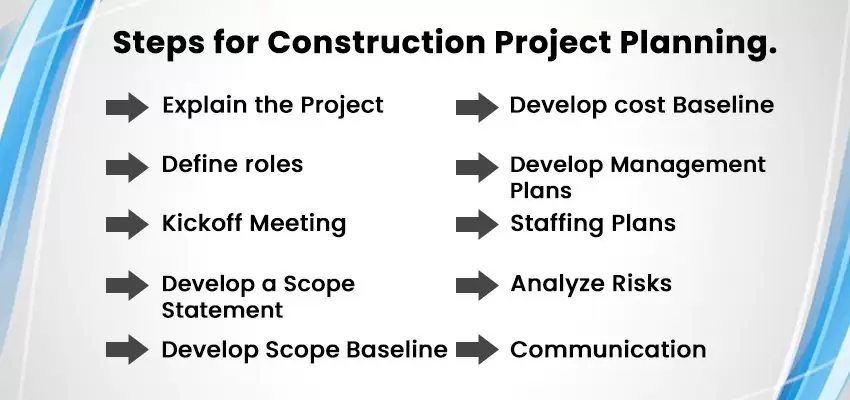Constructing any project Plan is a long and tuff endeavor, especially if you are planning to do it yourself, take a look at the 10 steps which will definitely help you in streamlining the process.
- You have to explain the project plan to the key stakeholders and discuss the main components of the project plan.
- Define roles and responsibilities
- Hold a kickoff meeting
- Develop a scope statement
- Develop a scope baseline
- Developing the schedule and cost baselines
- Create baseline management plans
- Develop the staffing plans
- Analyze the project quality and risks involved
- Communication one needs to create a project plan before heading into developing a construction project. As given above the whole rationale of your basic plan can be laid out in 10 steps as given above. This is to be made before you begin construction.
What is a Project Plan?
Post your Requirement
The project plan is the major work product in the entire planning process as it contains all the planning project documents. so as mentioned step 1 deals with making the key stakeholders understand the entire plan of action. Who are these? The owners or financers, the builders, contractors, project managers, engineers, architects and the final consumer could be flat owners or reps for them. The key components of the project plan need to be discussed with all. The various documents are handed out, regarding budget, costing, materials, timeline and phased schedules etc. Once changes are made and the documents are streamlined and thrashed out, a final consensus is reached and taken further.
Enquire Now: Construction Materials
Step 1: What is the components of the project plan:
- Baseline: This is saying the same thing in a formal way.
The project`s three starting points are the scope, schedule, and cost baselines ascertaining that the project is on track and collinear with execution. - Management plans: These plans sum up what changes may occur in the main plan throughout execution and the need for additional planning if there are changes in the baseline- whichever aspect is applicable. What process will be followed, who will be notified and how these changes will be notified, and to who and who will do the extra funding. Other work products include a risk management plan, a quality plan, a staffing plan, and a communicative plan.
Step 2:To define the role and responsibilities of all the people involved.
Some of the key players are:
- Project Sponsor: The person bringing in the funds. He must be aware of the entire plan.
- Assigned business experts: These will decide what is needed for the project to be executed. They also help develop the scope baseline and approve the ‘scope document’. They are also connected with the timeline, and the approximate time that will be taken for project completion.
- Project manager: This is the key person responsible for the creation, execution and control of the project. They are the builders of the plan so they are important as well.
- Project team: They build the building. They may participate in the planning stage but needn`t approve plans. Essentially the executors of the approved plan.
- End-users: This could be the staff, or a homeowner of an apartment block, which may or may not be in the planning stage.
- Others: Auditors, quality or risk analysts, procurement specialists etc. May bunch in with quality or procurement plan.
Step 3: Holding a kickoff meeting brings the stakeholders together to discuss the project.
Topics included could be:
- Business vision and POA (sponsor)
- Project vision (sponsor)
- Roles and the various responsibilities
- Team building
- Commitments from the team
- How the team will make decisions
- Ground rules to be followed
- How large the groups should be and if sub-groups need to be formed.
Step 4: Developing a statement of ‘scope’ is probably the most important document in the whole plan.
The scope statement clearly defines what the project outcome will be.
- Business needs and problems that one might meet.
- Objectives of the project, stating how problems might be resolved.
- Project justification and benefits
- The project scope includes what will be discarded, what will be accepted for the project. Example: Marble floors and not wooden ones.
- Key milestones or phases of work. The approach and other parts as needed as per the size and nature of the project.
- Like a contract between the sponsor and project manager, one with changes only having to be vetoed by the sponsor.
Step 5: Developing a scope baseline to break down structure (WBS)
This is basically a breakdown of all the deliverables in the project. It has the following elements.
- Identification of all the deliverables produced on the project, all work to be done.
- Taking up large deliverables for example: how many rooms, their dimensions, materials needed, equipment needed. Subunits of deliverables in hierarchical order. So bringing it down to lower and lower levels of detail.
- The lowest level is called `work package` and can be in numerical order corresponding to all the activities and tasks.
Step 6: Developing schedule & cost baselines to identify the resource & cost.
- Identifying activities and tasks which are needed to produce each ‘work package’, developing thus a WBS of tasks
- Identifying the resources needed for each task
- Setting timelines or durations for each activity
- Calculating the cost of each task
- Considering constraints of resources, how much time is needed for each resource
- Seeing how tasks are intertwined.
- Scheduling tasks with time step by step
- Time phased budget or cost by time period
This process is not a one-time effort. Many steps will be taken and retaken as you go along.
Step 7: Creating a baseline management plan for modification.
Management plans include a review and approval process for modification of the baseline. New requests for change will be added as per requirement.
Step 8: Developing the staff plan for better cost projections.
Deciding who will stay and for how long and how others will be reinstated as resources Eg labor, plumbers, supervisors, contractors.
Step 9: Frequent inspections to analyze project quality and a better understanding of risks.
Make sure that the end product will follow specifications decided upon and maintenance of uniform quality. The plan must become a foundation for all quality reviews and inspections which are being performed during the project and are used throughout the project`s execution.
Project Risks:
Any changes which might occur example: the sponsors changing hands and what will be the impact on the project and how the project will bear the impact or continue efficient functioning in spite of the risk/change.
Step 10: Communicate to create clarity of progress.
- Who all in the project will receive regular reports of work, how often and in what format and song, which media.
- How various issues will be highlighted and when?
- Where the project will be stored and who all can have access to it. This entire communication especially for the sponsor will include:
- Review and approval of the 2 project
- Process for changing the contents of the plan
- Next steps- executing and control of project plans and roles of key stakeholders in upcoming phases.
Use this all-comprehensive guide to plan your next construction project. The building materials used in construction are:
- Wood
- Plastic
- Glass
- Metal
- Cement
- Bricks & Blocks
- Concrete
Enquire Now: Building Materials























Post A Comment